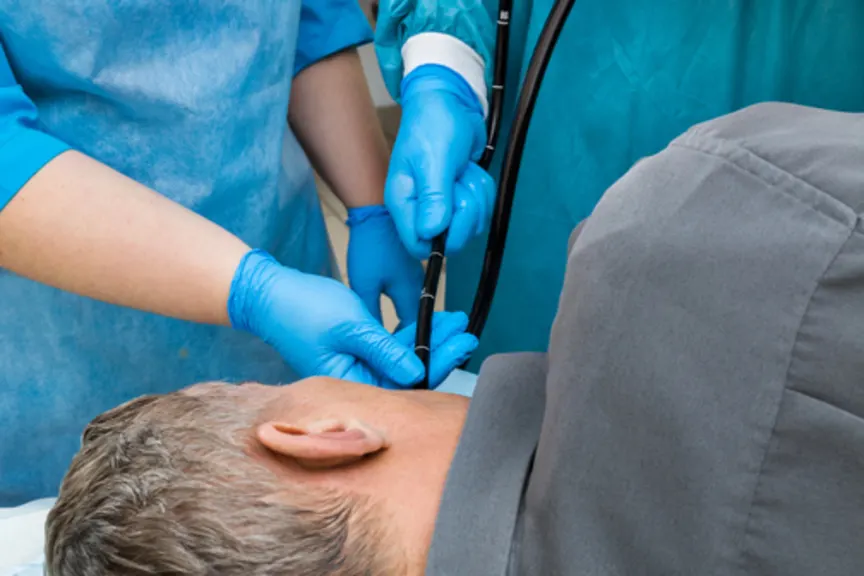
Upper Endoscopy
What is an upper endoscopy?
An upper endoscopy is a procedure to examine the upper part of the digestive tract. The procedure is also called an esophagogastroduodenoscopy, or EGD.
A gastrointestinal (GI) doctor (gastroenterologist) uses an endoscope. The scope is a narrow, flexible tube with a light and small video camera. Through the scope, your doctor can view the inside lining of your:
- Esophagus: The tube that carries food from your mouth to your stomach.
- Stomach: The organ that holds food and starts the digestion process.
- Duodenum: The upper part of your small intestine.
Who might need an upper endoscopy?
You may need an upper endoscopy if you have unexplained:
- Abdominal pain.
- Bleeding in the upper digestive tract.
- Nausea and vomiting.
- Swallowing problems.
- Weight loss.
Why do healthcare providers perform upper endoscopies?
An upper endoscopy allows for a direct view and biopsies. It can be more accurate than X-rays in diagnosing problems in the upper digestive system. These problems include:
- Acid reflux (gastroesophageal reflux disease or GERD) and heartburn.
- Cancerous and noncancerous tumors.
- Inflammation, such as esophagitis, gastritis, and duodenitis.
- Gastrointestinal disorders, such as celiac disease and Crohn’s disease.
- Stomach (peptic) ulcers.
- Swallowing disorders.
What does an upper endoscopy treat?
Healthcare providers can also do treatments with an endoscope. Your doctor may also use upper endoscopy to:
- Control upper digestive tract bleeding.
- Stretch narrowed digestive tracts.
- Remove polyps, tumors, or swallowed objects.
What other procedures use upper endoscopy?
Your doctor may combine an upper endoscopy with:
- X-rays: In endoscopic retrograde cholangiopancreatography (ERCP), doctors combine the two tools with injected dye. ERCP helps diagnose and treat problems that affect the liver, pancreas, gallbladder, and bile ducts.
- Ultrasound: An endoscopic ultrasound (EUS) creates images of the digestive tract. EUS can also show surrounding organs, lymph nodes, and tissue.
PROCEDURE DETAILS
What should I expect before an upper endoscopy?
To help your doctor clearly view the digestive tract, you should go into the procedure with an empty stomach. Your doctor will review the preparation with you. You may need to prepare with:
- Food and drink: Consume only clear liquids (broth, gelatin, popsicles, water, black coffee, or tea) for six to eight hours before the procedure.
- Medications: Stop taking medicines that thin blood or affect blood clotting, including aspirin. You may need to switch medications for diabetes or high blood pressure. Follow your doctor’s recommendation.
How is an upper endoscopy performed?
An upper endoscopy is typically an outpatient procedure, meaning you go home the same day. The procedure may be uncomfortable, but it shouldn’t be painful. You’ll receive an intravenous sedative or another form of anesthesia. Someone should drive you home after the procedure.
You lie on your left side during the procedure, which takes about 30 minutes. Your doctor:
- Administers a numbing spray to your throat and inserts a mouthguard to protect your teeth.
- Guides the endoscope through your mouth and down into the esophagus, stomach, and duodenum.
- Pumps air through the endoscope into the stomach and duodenum to make it easier to see organs.
- Views images from the endoscope on a video monitor while looking for problems or performing treatments.
- Removes small pieces of tissue to biopsy (examine in a lab), if necessary.
- Performs treatments, if needed.
What should I expect after the upper endoscopy?
You’ll spend some time recovering while the sedative wears off before going home. An upper endoscopy can irritate your throat. You may be hoarse or have a cough for a few days. You can eat soft foods, drink ice water, and use throat lozenges until the soreness subsides.
After the procedure, you may experience some bloating (a swollen feeling from the pumped-in air) and nausea (an anesthesia side effect). With your doctor’s approval, you should be able to resume your usual activities, including working and driving, the next day.
RISKS / BENEFITS
What are the potential risks or complications of upper endoscopy?
An upper endoscopy is a relatively low-risk procedure. Potential complications include:
- Allergic reactions to the sedative.
- Digestive tract bleeding or infection.
- Tear (perforation) in the digestive tract lining.
